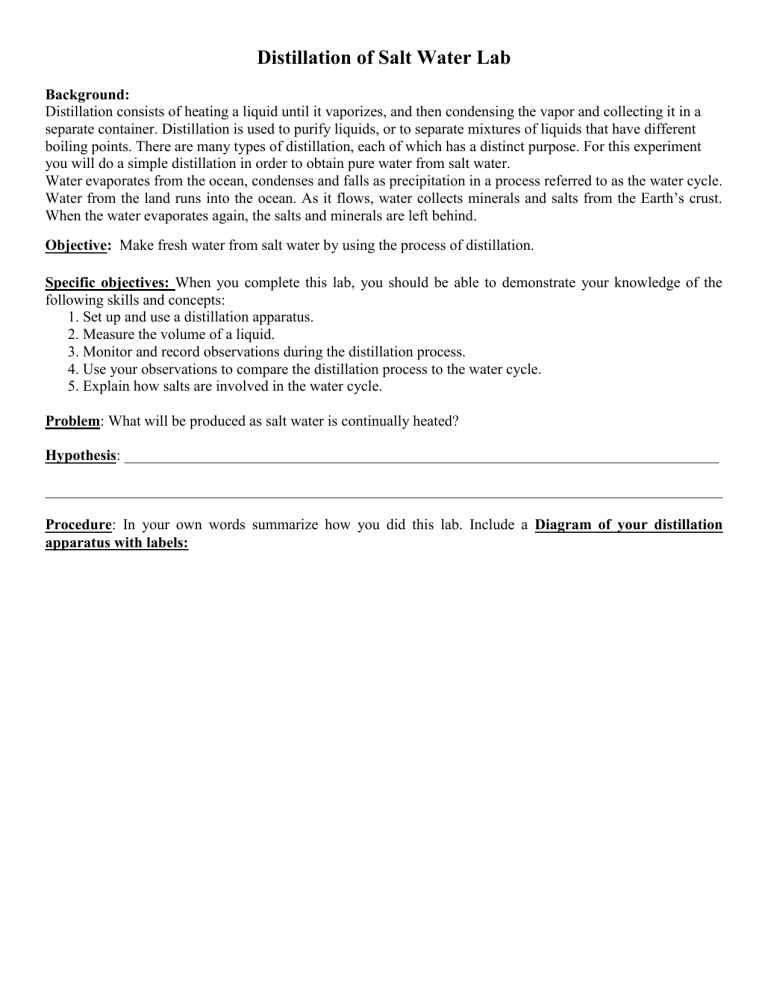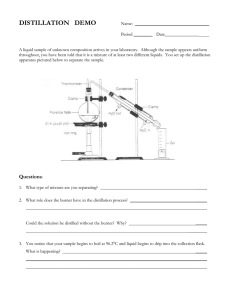
Distillation of Salt Water Lab Background: Distillation consists of heating a liquid until it vaporizes, and then condensing the vapor and collecting it in a separate container. Distillation is used to purify liquids, or to separate mixtures of liquids that have different boiling points. There are many types of distillation, each of which has a distinct purpose. For this experiment you will do a simple distillation in order to obtain pure water from salt water. Water evaporates from the ocean, condenses and falls as precipitation in a process referred to as the water cycle. Water from the land runs into the ocean. As it flows, water collects minerals and salts from the Earth’s crust. When the water evaporates again, the salts and minerals are left behind. Objective: Make fresh water from salt water by using the process of distillation. Specific objectives: When you complete this lab, you should be able to demonstrate your knowledge of the following skills and concepts: 1. Set up and use a distillation apparatus. 2. Measure the volume of a liquid. 3. Monitor and record observations during the distillation process. 4. Use your observations to compare the distillation process to the water cycle. 5. Explain how salts are involved in the water cycle. Problem: What will be produced as salt water is continually heated? Hypothesis: _______________________________________________________________________________ __________________________________________________________________________________________ Procedure: In your own words summarize how you did this lab. Include a Diagram of your distillation apparatus with labels: Data: Each minute from start to finish, record your observations of the salt water flask, glass bends and tubing, and collection test tube. Be sure to note any changes observed. Time Saltwater container (minutes) 1 2 3 4 5 6 7 8 9 10 11 12 13 14 15 16 17 18 19 20 Glass or tubing or connectors Collection beaker or test tube Salt is also known as sodium chloride. The presence of chloride ion in solution is indicated by formation of the white precipitate AgCl when silver nitrate solution is exposed to it. Prepare a small test tube to see how well you have separated the salt from the water by adding 2 ml of your distillate. Take these to Mrs. Wiley. I will have a sample of the Original Saltwater in a test tube and a sample of Distilled Water in another test tube. I will add 5 drops of Silver nitrate solution to each tube. Relative concentrations are indicated by the amount of precipitate formed. (A precipitate is a solid that forms in a chemical reaction.) Record your observations and compare: Original Saltwater test tube: __________________________________________________________________ Your Distillate test tube: ____________________________________________________________________ Distilled Water test tube: ____________________________________________________________________ Conclusion: (1)State if your hypothesis was supported or negated by the data in this lab and (2) what you found out to be the true results. (3)List any errors that you made. (4)List any improvements you would make if you did this experiment again. Conclusion Questions: 1. Why does the liquid in the flask become a gas? _________________________________________________ 2. What is this process called? ____________________________________ 3. What part of the water cycle does this represent? ________________________________________________ _________________________________________________________________________________________ 4. Where did the liquid you collected come from? _________________________________________________ 5. What is this process called? ______________________________________ 6. Would the liquid in the test tube be safe to drink? Explain your answer. _____________________________ __________________________________________________________________________________________ 7. Explain why the salts should not evaporate with the water. ________________________________________ __________________________________________________________________________________________ 8. If you were trapped on an island without water, explain how you could use what you learned to make ocean water drinkable. (Be specific in your answer and your design.) _______________________________________ __________________________________________________________________________________________ __________________________________________________________________________________________ 9. What is an element? _______________________________________________________________________ 10. What is a mixture? _______________________________________________________________________ 11. How does a mixture differ from a compound? ________________________________________________ __________________________________________________________________________________________ 12. What is meant by boiling point? ___________________________________________________________ 13. What is the boiling point of water? _______________________ 14. What is distillation? ____________________________________________________________________ _________________________________________________________________________________________ 15. Why are we or why should we be concerned about changing sea water into regular drinking water? __________________________________________________________________________________________ __________________________________________________________________________________________



